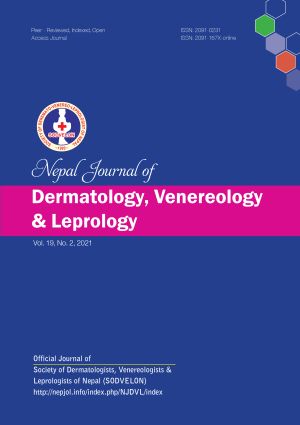Clinicoepidemiolgic Profile of Dermatophytosis in the Elderly: A Hospital Based Study
DOI:
https://doi.org/10.3126/njdvl.v19i2.38496Keywords:
Dermatophytosis, Epidemiology, GeriatricAbstract
Introduction
Superficial tinea infections are some of the most common dermatological conditions in the elderly. Recently, few studies done showed an abrupt increase in dermatophytic infection in adults; however, similar recent studies describing dermatophytosis in the elderly are lacking. The aims and objectives of this study were to identify the epidemiological profile of dermatophytoses among the elderly population.
Materials and Methods
This was a single centre, observational cross-sectional study conducted at a tertiary care Medical College Hospital in North India over 12 months including patients of dermatophytosis (KOH confirmed) aged 60 years or more.
Results
A total of 192 patients were enrolled, among which 68.7% were males. The extensive disease was present in 56.2%. History of topical steroid usage was present in 79.2%. The mean duration of disease was 23.8 weeks among which chronic disease was seen in 25%. Various other demographic characteristics were identified. Various risk factors for extensive disease, like gender, topical steroids use, urban residence, higher socioeconomic status, longer duration of disease, positive family history, diabetics, regular alcohol and tobacco consumption, were also noted in the present study.
Conclusion
The present concludes increased prevalence in women, delay in seeking treatment among them, a rising proportion of chronic and extensive dermatophytosis, rising atypical clinical presentation and higher predilection for tinea cruris and onychomycosis.
Downloads
Downloads
Published
How to Cite
Issue
Section
License
Copyright (c) 2021 Society of Dermatologists, Venereologists and Leprologists of Nepal

This work is licensed under a Creative Commons Attribution 4.0 International License.
Copyright on any research article is transferred in full to Nepal Journal of Dermatology, Venereology & Leprology upon publication. The copyright transfer includes the right to reproduce and distribute the article in any form of reproduction (printing, electronic media or any other form).




